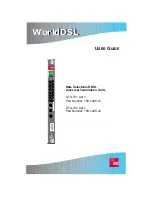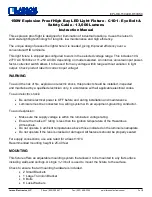
LTPE-UG-1017-01 Issue 1
Overview
UTU-731 List 1 and UTU-732 List 1
February 15, 2001
1
O
VERVIEW
The ADC
®
WorldDSL
™
Universal Termination Units (UTUs), models
UTU-731 and UTU-732, are single-pair rate selectable High-bit-rate Digital
Subscriber Line (HDSL) units produced in the Telebras form factor. The units
install in 20-slot Telebras shelves or in single-slot Telebras enclosures. The
units can be configured as Line Termination Units (LTUs) or Network
Termination Units (NTUs). The default configuration is NTU.
LTUs are the Exchange Office side of a repeaterless E1 transmission system.
They transport data to a remote NTU over the HDSL loop at rates of up to
2048 kbps (the standard E1 rate).
The UTU-731 and UTU-732 receive power from the Telebras shelf or
enclosure in which they are installed.
A
PPLICATION
I
NTERFACE
The UTU-731 has a G.703 E1 interface that can be configured for an
impedance of 75
Ω
unbalanced or 120
Ω
balanced. Data is structured or
unstructured according to the G.704 framing standard, and optionally CRC4
multiframed according to the G.706 standard. Structured mode is invoked
automatically when 1 to 31 time slots are selected. Unstructured mode is
invoked when 32 time slots are selected.
The UTU-732 has an Nx64k serial data port interface with user-selectable
protocols that conform to the V.35, V.36, X.21, or RS-530 (RS-449)
standards.
The only application mode is Single, indicating single pair.
The UTU-731 and UTU-732 have HDSL payload rates ranging from
64 kbps to 2048 kbps. The exchange office data terminal equipment (DTE)
allocates the 2048 kbps payload to the G.703 and Nx64k ports in time-slot
increments of 64 kbps each. The number of time slots allocated by the DTE
is determined by the user-selected HDSL payload rate (the DTE and HDSL
payloads must be set to the same rate).
The HDSL system is configured at the LTU, either through front-panel switch
settings or through menu selections made at a maintenance terminal. When
using a maintenence terminal to configure the system, the menu selections are
applied to both the LTU and NTU. When using the front-panel switches to
configure the system, the LTUs and NTUs must be individually configured
(the switch settings are applied to the LTU and then repeated for the NTU).












































